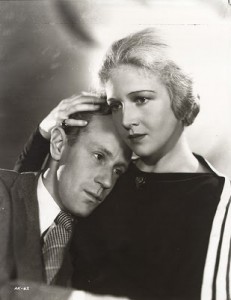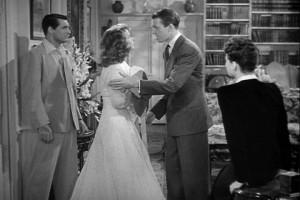 by Daisy Sage and KatScratchFever
by Daisy Sage and KatScratchFever
Daisy: KatScratchFever and I decided to write this article, to both complain about and explore the reasons why it seems like we can’t find cute clothes of decent quality to purchase on a working persons budget for several years now.
Neither Kat nor I are extremely overweight or oddly put together in any way. We are both quite fab, as a matter of fact. Kat is tall, well built, and striking. My body type could be described as a short (5’4”) version of Christina Hendricks, with more or less her same differences in measurements, if you shave a couple of inches all over (I found this out when they were auctioning off some of her Mad Men dresses online and printed all the dress measurements.)
However we are both grown up women whose figures are not flattered by the thin tubes of crappy fabric run up by some poor 12 year old in a sweatshop somewhere, desperately trying to not to lose consciousness until the next rice and water break, for the purposes of filling the burgeoning racks at the likes of Forever 21 or even H&M.
What follows is a dialogue between Kat and I, to explore the reasons for this dilemma, and find possible solutions.
Daisy: When did you first start noticing that it was so difficult to find nice clothes that were affordable?
Kat: It probably started years ago, but I wasn’t fully conscious of it until I was out of college, had a full-time job and began budgeting and being critical of the things I was spending my money on. I very much want to subscribe to the idea that “I’m too poor to buy cheap”, but in the case of clothing, it seems almost impossible. Housewares and furniture have the kind of longevity that makes it rewarding to have a “buy less, buy better quality” ethos, but clothes are not as durable. You spill things on them. The cat swipes at you as you walk by and rips a hole in them. You slip on the four inches of ice crust the Snowpocalypse left in its wake and tear them. They wear out in the horrible industrial washing machines you use because you don’t have the luxury of laundering things in your apartment. You can’t afford to have your entire wardrobe dry-cleaned once a week.
Daisy: Indeed. In the last few years, I have lost several clothing items I liked through “attrition”; i.e. tossed out worn things, or given them away in a fit of feng shui, only to wait in vain for proper replacements to magically appear. I still pine for a perfect pair of royal blue velvet jeans that I wore threadbare in places to the point that they tore across the ass, which you can’t really repair. (Maybe the velvet jeans and I could have made it work out, somehow.) I currently have in particular a “jeans deficit”.
Consider the dichotomy of two pairs of Gap jeans I own. One of them is one size larger than the size I have normally worn for years, that I bought when I had gained a little weight. Since, then, I’ve lost some of that weight, and these jeans are now so large on me that I can only wear them in public for very short jaunts down the street, covered by a very long sweater (because they WILL inevitably fall all the way down on my ass if I don’t catch them in time).
Conversely, another Gap pair of jeans I own, which the label says is the size I have traditionally worn, (just one number size below the ass hanging ones) are so still so tight on me that I can only get them on by lying on the bed and doing a type of yoga breathing exercise in which I expel and exhale all the oxygen from my body on a cellular level.
A third pair, also in my regular size fits just fine, but the fronts of the legs have worn so thin, and have rips from constant wear, that they are only suitable to wear on a hot summer day to a HORDE concert, and I’m not sure they have those anymore.
I’ve been told by those who know clothing manufacturing that in the last few years, the Gap is so loosey goosey about pattern cutting in their factories, that you could try on 10 different pairs of their jeans, all ostensibly the same size, and not one of them would be the same size or shape.
Kat: Most certainly, in the last four or five years I’ve noticed a decline in quality, or a huge jump in price, from the places that used to be my stalwarts for reasonably priced, well-made women’s clothing (the Gap and J Crew come to mind), and by far my overall satisfaction with the stores where I used to achieve moderate success on this front (H&M, for example) has gone way, way down.
Daisy: I concur. H&M is a sad shell of its former self, selling various sad shells of clothing. I find it useful to stop in for a random pair of sunglasses or socks when I pass by, but that’s it. Although, I must admit, I bought a sundress there last summer on sale for $10 that I didn’t even try on, and it ended up looking great on me. Go figure. Anyway, Kat, what is your opinion about why this decay in our clothing options has happened?
Kat: My opinion is that this is a result of a giant mess of apathy on all fronts. The general public no longer cares how they look, or at the very least takes minimal pride in putting themselves together well. Clothing retailers are apathetic about the quality and construction of their product and care mostly about their net profitability. Everyone cares more about being “Fashionable” and “Hip” than dressing appropriately for your body. We live in a throwaway society, which has little respect for high production standards. I think that much in the way that some people say there is “no middle class” anymore (or it will be that way in the very near future), there is no real “middle class” for clothing, only expensive boutique garments, and things that I will end up using as cleaning rags in six months or less.
Daisy: I think what you say makes a lot of sense. It seems like even moderately priced clothing of decades ago was constructed so much better than today. And the dye colors of the fabrics were more rich and vivid. I once had an A-line winter skirt my mom had worn when she was young, bright blue mohair, lined, with a fuchsia and dark purple thin plaid pattern over it. Below the knee, side zip, kick in the back. I kept that thing together for years re-sewing ripped or loose seams, fixing belt loops, until I gave up on holding it together. I know I won’t find anything like that again, outside of a high-end boutique.
Kat, what is one of your worst shopping for clothes experiences in the last few years? Which retailers do you detest the most and why?
 Kat: Oh, there are many, but this one still stings. I was in H&M (on a budget, as usual) in the dressing room with about seven dresses to try on for a wedding I was to attend. Most of them wouldn’t zip or were too weirdly shaped or too revealing and I was growing frustrated and running out of time. The fifth frock had a side zip, but to put it on I had to slide my arms into the sleeves and pull it over my head. Overall it fit so damn well, except that the short sleeves were obviously tailored for a size 10 woman with size 0 waif arms and my barrel chest was stuffed so tightly in that it was difficult to breathe (a typical clothing woe of mine). Defeated, I tried to take it off by first pulling my arms out of the sleeves, but they were so crammed in there they wouldn’t budge. I tried to pull it up at the waist over my ribs to give the arms a little slack, but still, no dice. I finally resorted to a technique I’m sure many women have used before in this situation: hike dress up over hips, bend in half at waist, cross arms around body and try to slowly inch the dress off inside-out, peeling your sausage arms out last. This time though, it didn’t work, and now I thought I’d have to call the dressing room attendant for help. Some sort of dressing room rage took over at this point, and I just started flexing my arms and yanking at the thing, which finally ripped, giving me enough extra room to extract myself and fling the dress on the floor, ready to HULK SMASH!!! I put it back on the hanger, hid it between the other dresses, gave everything back to the attendant and went to the closest bar to quell my rage with a bottle of wine.
Kat: Oh, there are many, but this one still stings. I was in H&M (on a budget, as usual) in the dressing room with about seven dresses to try on for a wedding I was to attend. Most of them wouldn’t zip or were too weirdly shaped or too revealing and I was growing frustrated and running out of time. The fifth frock had a side zip, but to put it on I had to slide my arms into the sleeves and pull it over my head. Overall it fit so damn well, except that the short sleeves were obviously tailored for a size 10 woman with size 0 waif arms and my barrel chest was stuffed so tightly in that it was difficult to breathe (a typical clothing woe of mine). Defeated, I tried to take it off by first pulling my arms out of the sleeves, but they were so crammed in there they wouldn’t budge. I tried to pull it up at the waist over my ribs to give the arms a little slack, but still, no dice. I finally resorted to a technique I’m sure many women have used before in this situation: hike dress up over hips, bend in half at waist, cross arms around body and try to slowly inch the dress off inside-out, peeling your sausage arms out last. This time though, it didn’t work, and now I thought I’d have to call the dressing room attendant for help. Some sort of dressing room rage took over at this point, and I just started flexing my arms and yanking at the thing, which finally ripped, giving me enough extra room to extract myself and fling the dress on the floor, ready to HULK SMASH!!! I put it back on the hanger, hid it between the other dresses, gave everything back to the attendant and went to the closest bar to quell my rage with a bottle of wine.
Daisy: Oh I’m feeling your pain there. I have experienced the existential angst of being trapped in a cheap dress in a try on room, on more than one occasion. Either I couldn’t get it up over my chest or down over my hips. As I pulled on it, I wondered how I got into it in the first place. It’s completely exhausting. You CAN’T be trapped in a dress, except yes, you are. I would not fault you one bit for ripping the freaking thing. What else were you supposed to do? I’m sure H&M survived the potential loss of the $1.67 the dress was actually worth (as opposed to the $29.99 it probably retailed.)
Kat: As for hated retailers, Forever 21 is just the worst. Other cheapo stores like Rainbow and Strawberry get lumped in there as well. Most of them don’t even have dressing rooms and the ones that do are so small I barely have room to try anything on. I’m convinced this is because they know if you can’t try stuff on you will likely buy it anyway because it’s cheap, and the likelihood of you coming back the within the time frame of their return policy (usually 7 days if you want your cash back, not store credit) is slim. It’s a racket, I tell ya.
Daisy: I didn’t even know Rainbow was still around. The last time I was in one was years ago. I was working part time for a small business out near the east end of Long Island. There was practically nothing around in the way of civilization, so many times on my lunch break, I would get some kind of fast food, and then go wander around the Rainbow in the local strip mall. It gave me something to do, and I figured I might find a clothing item in my price range. Never found anything there except a customer base of old before their time “Sixteen and Pregnant” candidates pushing double strollers and their irate moms. The merchandise was not only depressing; some of it was literally dusty. I felt as though it was the retail store that time forgot.
Kat: Why do you think it is that it is still so hard for “normal” shaped/sized women to find well fitting clothes? Is it because retailers are still trying to mimic the high-fashion world where everyone is a size 2, despite the actual size of their clientele?
Daisy: I think it is a convergence of a couple of things. Yes, I do think retailers are trying to mimic the high fashion, size 2 model, because it is what is promoted in the magazines, and there is a burgeoning demographic of young girls who either naturally fit into that stuff, or are willing to starve themselves to do so. Also, I think that as food manufacturers have over the last few years managed to keep the prices of packaged foods relatively stable by sneakily reducing the size of the packages and/or the portions of food inside them, that clothing manufacturers are able to sell cheap clothing by using less fabric, and lower quality fabric to make the bulk of their clothing.
Kat: I like equating the cheap wardrobe I have that is filling my closet and dresser but leaving my soul empty to fast food and portion sizes. Your analogy is very apropos.
Daisy: Thank you. So Kat, what do you think is the way forward for stylish ladies such as us to dress ourselves well? Vintage? Ebay? Vigilant Goodwill shopping? Sewing?
Kat: I think Muumuus are the wave of the future. In twenty years everybody will be bulbous piles of jelly zipping around on scooters ala Wall-E and I won’t ever have to wear another pair of pants again. (Fingers crossed!) Here’s where I’m hoping our fellow Crasstalkers have some opinions and advice to soothe our wardrobe-weary souls. I have always been interested in learning to sew, but continuously fail at finding the time or finishing beginner projects. Since my sewing skills are only advanced enough to make tote bags, unless I cobble all fifty of them I have into a utilitarian, carryall ToteMuumuu, I won’t be wearing any homemade garments any time soon. I scour thrift stores regularly, but everything worth buying has long been picked over in NYC by all the fly-by-night Ebay vintage store mavens and Brooklyn Flea Market clothing hoarders. My girlfriends are all in the same situation as I, and though we sometimes do clothing swaps, none of us have a go-to store for new items that stand the test of time. Your ideas?
Daisy: I actually can sew, although I haven’t touched the machine in years. It is a whole lot of work, as you say.
As to the clothing swap thing, it’s the kind of idea that sounds fun, but for me is not that practical because my female friends are all different heights and sizes. And even if we fit into each others clothes perfectly, it seems like rearranging deck chairs on the Titanic.
Personally, I’m very excited about your ToteMuumuu™ concept. Let’s speak privately about trademarks and lining up investors. If we hurry, we can hire an Indonesian manufacturer, and roll that sucker out to the floors of the women’s departments of Sears and JC Penneys within a month. (Of course you will have the final say on whether the samples live up to your aesthetic vision.) After we cash in, we can buy ourselves wardrobes from high-end boutiques and have all our clothing tailored.










 Kat: Oh, there are many, but this one still stings. I was in H&M (on a budget, as usual) in the dressing room with about seven dresses to try on for a wedding I was to attend. Most of them wouldn’t zip or were too weirdly shaped or too revealing and I was growing frustrated and running out of time. The fifth frock had a side zip, but to put it on I had to slide my arms into the sleeves and pull it over my head. Overall it fit so damn well, except that the short sleeves were obviously tailored for a size 10 woman with size 0 waif arms and my barrel chest was stuffed so tightly in that it was difficult to breathe (a typical clothing woe of mine). Defeated, I tried to take it off by first pulling my arms out of the sleeves, but they were so crammed in there they wouldn’t budge. I tried to pull it up at the waist over my ribs to give the arms a little slack, but still, no dice. I finally resorted to a technique I’m sure many women have used before in this situation: hike dress up over hips, bend in half at waist, cross arms around body and try to slowly inch the dress off inside-out, peeling your sausage arms out last. This time though, it didn’t work, and now I thought I’d have to call the dressing room attendant for help. Some sort of dressing room rage took over at this point, and I just started flexing my arms and yanking at the thing, which finally ripped, giving me enough extra room to extract myself and fling the dress on the floor, ready to HULK SMASH!!! I put it back on the hanger, hid it between the other dresses, gave everything back to the attendant and went to the closest bar to quell my rage with a bottle of wine.
Kat: Oh, there are many, but this one still stings. I was in H&M (on a budget, as usual) in the dressing room with about seven dresses to try on for a wedding I was to attend. Most of them wouldn’t zip or were too weirdly shaped or too revealing and I was growing frustrated and running out of time. The fifth frock had a side zip, but to put it on I had to slide my arms into the sleeves and pull it over my head. Overall it fit so damn well, except that the short sleeves were obviously tailored for a size 10 woman with size 0 waif arms and my barrel chest was stuffed so tightly in that it was difficult to breathe (a typical clothing woe of mine). Defeated, I tried to take it off by first pulling my arms out of the sleeves, but they were so crammed in there they wouldn’t budge. I tried to pull it up at the waist over my ribs to give the arms a little slack, but still, no dice. I finally resorted to a technique I’m sure many women have used before in this situation: hike dress up over hips, bend in half at waist, cross arms around body and try to slowly inch the dress off inside-out, peeling your sausage arms out last. This time though, it didn’t work, and now I thought I’d have to call the dressing room attendant for help. Some sort of dressing room rage took over at this point, and I just started flexing my arms and yanking at the thing, which finally ripped, giving me enough extra room to extract myself and fling the dress on the floor, ready to HULK SMASH!!! I put it back on the hanger, hid it between the other dresses, gave everything back to the attendant and went to the closest bar to quell my rage with a bottle of wine.